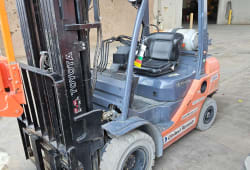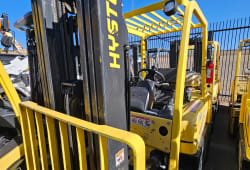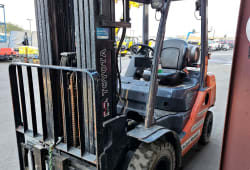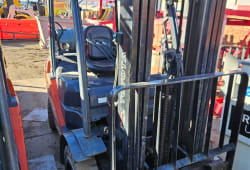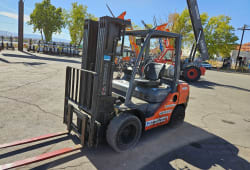Tricks on How to Choose the Right Forklift for Your Business Needs
9 Min read
)
January 6, 2024
Selecting the right forklift is vital for the seamless functioning of your business. Surprisingly, the process involves more considerations than one might think. Choosing the right forklift for your company entails a thorough evaluation of various factors.
This includes assessing your warehouse's layout, determining load capacity, considering noise and emission levels, and accounting for the terrain. Utilizing this comprehensive guide will help you prioritize the specific needs of your organization when selecting a lift truck. By thoroughly evaluating these criteria, you ensure that the chosen forklift aligns precisely with the unique demands of your business, contributing to its overall efficiency and productivity.
Assess Your Requirements
Choosing the proper forklift for your organization entails considering everything you require it to do. Keep the following elements in mind when looking for warehouse forklifts and machinery:
Warehouse Layout and Size
When evaluating forklifts, it's imperative to consider the unique layout and dimensions of your warehouse space. Factors such as aisle width and shelf height should influence your choice, ensuring the forklift can navigate efficiently and reach required storage levels, optimizing overall warehouse operations.
Load Capacity
Accurately determining the weight of your average load is essential. This ensures that the selected forklift has the necessary strength and capacity to handle materials effectively, preventing potential safety hazards and optimizing productivity in material handling processes.
Noise and Emissions
Choose between electric and diesel forklift options based on your warehouse's location and emissions requirements. Electric forklifts are quieter and produce fewer emissions, making them suitable for indoor and urban environments. On the other hand, diesel forklifts might be preferable for outdoor applications, offering more power and speed.
Terrain
Tailor your forklift selection by considering the specific terrain of your warehouse. For indoor operations, cushion tires are suitable for smooth maneuverability, while pneumatic or solid tires are ideal for outdoor or rough terrain use. This ensures that the forklift can comfortably navigate the warehouse environment, contributing to overall operational efficiency.
Types of Forklifts
Familiarize yourself with the types of forklifts available:
Reach Truck: Ideal for warehouses with tall shelves
:format(webp))
A reach truck is a specialized forklift designed for warehouses with tall shelves. Recognized for its exceptional vertical reach capabilities, it excels in efficiently loading and unloading items from deep or high pallets. The distinguishing feature of a reach truck is its extended fork, allowing it to safely access and retrieve items stored at elevated positions. This design is particularly advantageous in warehouse environments where maximizing vertical storage space is crucial. With its ability to navigate through narrow aisles and reach considerable heights, a reach truck becomes an invaluable asset for optimizing storage capacity and streamlining material handling processes in warehouse settings with vertically oriented storage configurations.
Narrow Aisle: Cost-effective and versatile for easy navigation
:format(webp))
Cost-effective and versatile solution designed for seamless navigation in confined spaces. These forklifts prioritize efficiency and versatility, making them ideal for warehouse operations where space is at a premium. With their compact design and enhanced maneuverability, narrow aisle forklifts excel in environments where aisles are limited in width. These forklifts ensure optimal space utilization without compromising on operator comfort and safety. Whether in retail spaces or densely packed storage areas, the narrow aisle forklift proves invaluable, allowing businesses to maximize storage capacity and streamline material handling processes with ease.
Counterbalance: Most commonly used, reliable, and designed for heavy loads
:format(webp)) The most common and reliable type, counterbalance forklifts are specifically designed to handle heavy loads with stability and precision. Their popularity in the warehousing industry stems from their exceptional reliability and ability to balance weight effectively. These forklifts boast a small turning radius, providing ease of maneuverability and control. Unlike reach or narrow aisle forklifts, the counterbalance type doesn't require additional mechanisms for load retrieval, making them highly efficient for a range of warehouse tasks. With a proven track record in reliability and load-bearing capacity, counterbalance forklifts stand out as a staple choice for various material handling needs.
The most common and reliable type, counterbalance forklifts are specifically designed to handle heavy loads with stability and precision. Their popularity in the warehousing industry stems from their exceptional reliability and ability to balance weight effectively. These forklifts boast a small turning radius, providing ease of maneuverability and control. Unlike reach or narrow aisle forklifts, the counterbalance type doesn't require additional mechanisms for load retrieval, making them highly efficient for a range of warehouse tasks. With a proven track record in reliability and load-bearing capacity, counterbalance forklifts stand out as a staple choice for various material handling needs.
Pallet Jack: Designed for moving pallets in tight spaces
:format(webp))
Crafted for efficient pallet movement within confined spaces, pallet jacks are indispensable tools in warehouse operations. These compact devices are designed to maneuver in tight areas, making them ideal for navigating through narrow aisles or crowded storage spaces. Their primary function is to lift and transport palletized loads of varying shapes, sizes, and weights with ease. Equipped with a small turning radius, pallet jacks excel at navigating the often-restricted layouts of warehouses. Whether loading or unloading, these purpose-built tools streamline pallet handling, enhancing overall operational efficiency in environments where space optimization is paramount.
Articulated: Handle materials in narrow spaces
:format(webp))
Renowned for their ability to operate efficiently in confined spaces, articulated forklifts feature a unique fork platform that can articulate, allowing left and right turns without moving the entire lift truck. This innovative design makes them exceptionally suited for navigating narrow aisles and maneuvering through tight corners in warehouses. The flexibility of the articulated fork platform enables precise material handling in restricted areas, making these forklifts indispensable for tasks that demand agility and spatial versatility. Their capability to access loads in small spaces contributes to enhanced operational efficiency, especially in environments where space optimization is a critical factor.
Side Loader: Has a side-mounted fork, suitable for tight spaces
:format(webp)) Distinguished by a side-mounted fork, side loader forklifts are tailored for operations in tight and confined spaces. The unique design allows these forklifts to rotate their forks 90 degrees while carrying a load, facilitating efficient material handling in areas with limited maneuverability. This feature makes side loaders particularly advantageous for navigating through narrow aisles and handling materials in environments where space is a premium. The ability to carry out precise movements and lift loads from the side enhances their utility in scenarios where traditional forklifts may face challenges. Overall, side loaders prove to be valuable assets in optimizing space utilization and ensuring effective material transport in constrained settings.
Distinguished by a side-mounted fork, side loader forklifts are tailored for operations in tight and confined spaces. The unique design allows these forklifts to rotate their forks 90 degrees while carrying a load, facilitating efficient material handling in areas with limited maneuverability. This feature makes side loaders particularly advantageous for navigating through narrow aisles and handling materials in environments where space is a premium. The ability to carry out precise movements and lift loads from the side enhances their utility in scenarios where traditional forklifts may face challenges. Overall, side loaders prove to be valuable assets in optimizing space utilization and ensuring effective material transport in constrained settings.
Order Picker: Assists with order-picking operations
:format(webp))
Specialized for order-picking operations, order picker forklifts play a crucial role in warehouse settings where precise and efficient picking of items is paramount. Equipped with forks designed for accessing and loading products during the picking process, these forklifts are instrumental in high-shelf scenarios. With the capability to reach heights of up to 40 feet, order pickers efficiently navigate through warehouse aisles, enabling operators to access items at various elevations. Their design focuses on enhancing the picking process, contributing to streamlining warehouse operations. From facilitating smooth inventory management to expediting order fulfillment, order picker forklifts are indispensable tools in optimizing the logistics and distribution workflow.
Engine Type
When considering the engine type for your forklift, it's essential to weigh the advantages of electric and gas-powered options. Electric engines offer a quieter operational experience and are powered by batteries, eliminating the need for refueling and making them environmentally friendly with lower emissions. These are particularly suitable for smaller warehouses and urban environments where noise reduction and environmental considerations are crucial. On the other hand, gas engines present a cost-effective alternative, providing more power and speed than their electric counterparts. They are well-suited for navigating challenging terrains and are preferable for heavy-duty applications and larger outdoor spaces where their robust performance is an asset. Here are some pros of each engine type-
Electric Engine
- Quieter operation.
- Battery-powered, eliminating the need for refueling.
- Environmentally friendly with lower emissions.
- Ideal for smaller warehouses and urban areas.
Gas Engines
- Cost-effective option.
- More powerful and faster than electric counterparts.
- Suitable for navigating challenging terrains.
- Better for heavy-duty applications and larger outdoor spaces.
Other Considerations
Aside from practical reasons, other important factors to consider when purchasing a forklift include safety, training, and maintenance. Operator training and certification are essential to ensuring that your workforce is qualified to safely operate the forklift models you have chosen. Braking systems, seat belts, lights, alarms, and other devices meant to protect workers and adapt to unique working circumstances all play an important role. Prioritizing forklifts with features that improve worker safety is critical. Furthermore, forklift maintenance and inspections are essential. Choose forklift models that are simple to maintain, allowing for routine maintenance and ensuring they pass inspections with ease, contributing to the durability and dependability of your fleet.
Cost Factors
When comparing forklifts, cost is a critical aspect in the decision-making process. The initial investment is an important issue, requiring you to choose between new, pre-owned, or leasing options based on your financial limits.
To ensure continuous affordability and operational sustainability, operating expenditures, including maintenance expenses and fuel or energy requirements, should be considered. Another critical element is longevity, which requires a comprehensive examination of the equipment's lifespan and durability.
By thoroughly considering these cost considerations, you can make informed decisions that match with your financial goals and assure the long-term performance of your forklift fleet.
Conclusion
Choosing the proper forklift is critical for smooth business operations. This detailed approach focuses on examining warehouse layout, load capacity, noise, emissions, topography, and individual forklift kinds. Understanding the benefits of reach trucks, short aisles, counterbalance, pallet jacks, articulated, side loaders, or order pickers provides a targeted decision. The choice of electric or gas engines has an impact on noise, refueling, and topographical factors. Safety features, operator training, and ease of maintenance all contribute to the overall reliability of the fleet. Cost aspects such as initial investment, operational expenses, and longevity are critical for making informed decisions. By taking these factors into account, organizations can ensure that their chosen forklift is well aligned with operational requirements, increasing efficiency and production.

Post acquisition of Boom & Bucket, the company he founded, Adam now leads Marketplace Growth for Ritchie Bros.

